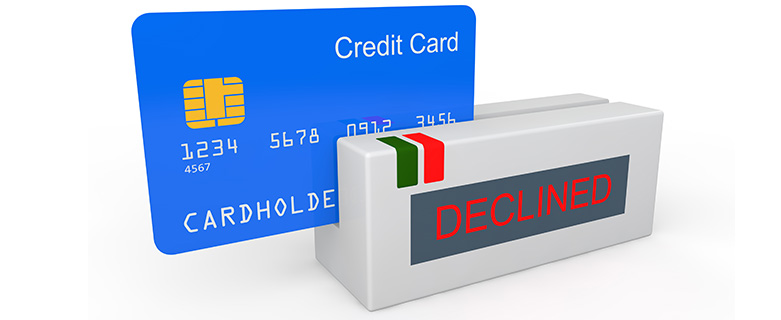
Understanding Credit Card Decline Rate: A Guide for Merchants
By Chris Alarie on Jul 26, 2023
Credit card decline rate is a crucial metric that merchants need to pay attention to when accepting credit card payments. Declines can be frustrating for both merchants and customers, leading to lost sales and revenue. In this article, we will discuss what credit card decline rate is, why it matters, and what merchants can do to reduce it.
What is Credit Card Decline Rate?
From a calculation standpoint, credit card decline rate is a simple metric: it is the percentage of credit card transactions that are declined. Credit card declines are payment card transactions that are not approved for one reason or another. The decision to decline the transaction could come from the payment gateway, the payment processor, or the cardholder’s issuing bank.
Transactions that are approved by the issuer but declined by the gateway or processor are sometimes known as soft declines. Soft declines often occur because of some technical issue preventing the completion of a transaction that the bank has been authorized. Because the bank has authorized the transaction, soft declines can usually be processed again or forced through by the merchant requesting settlement, resulting in the decline eventually becoming an approved transaction. Declines instituted by the issuer are known as hard declines and generally can’t be overridden.
Why Does Credit Card Decline Rate Matter?
Credit card decline rate matters primarily as an indicator of how frequent a merchant’s credit card transactions are declined. Unlike chargeback ratio, it does not carry specific consequences if a certain threshold is breached. And credit card decline fees are generally significantly smaller than fees for chargebacks. But credit card declines still produce negative consequences for merchants.
A credit card decline rate that runs higher than the 15% that Visa and Mastercard report as the national average indicates the possibility of some structural or systemic deficiencies that could prove enormously costly over time.
Credit card declines cost merchants the revenue from the sale as well as any operational costs associated with the purchase. It also produces frustration on the part of the cardholder and can potentially result in the loss of future sales or cancellations for subscription-based customers. Persistent decline rates can also cause friction in a merchant’s relationship with their acquiring bank.
Common Causes of Credit Card Declines
Credit cards can be due to cardholder errors, mistakes by merchants, technical problems, and fraud. Credit card declines are accompanied by a two digit, alphanumeric code that indicates the reason the charge was declined. Those codes and their associated meanings are as follows:
01 Refer to issuer
02 Refer to issuer (special condition)
03 Invalid merchant
04 Pick up card (No fraud)
05 Do not honor
06 Error
07 Pick up card (fraud)
10 Partial approval
12 Invalid transaction
13 Invalid amount
14 Invalid account number
15 No such issuer
19 Re-enter transaction
21 No action taken
25 Unable to locate record in file
28 File temporarily not available for update or injury
41 Lost card, pick up
43 Stolen card, pick up
51 Insufficient funds
52 No checking account
53 No savings account
54 Expired card
55 Incorrect PIN
57 Transaction not permitted - card
58 Transaction not permitted - terminal
59 Suspected fraud
61 Exceeds approval amount limit
62 Invalid/restricted service code
63 Security violation
64 Transaction does not fulfill AML requirement
65 Exceeds withdrawal limit
70 PIN data required
75 Allowable number of PIN entry tries exceeded
76 Unsolicited reversal
78 Blocked, first use
79 Already reversed
82 Negative CAM, dCVV, iCVV, or CVV results
85 No reason to decline
86 Cannot verify PIN
91 Issuer or switch unavailable
92 Unable to route transaction
93 Transaction can't be completed - violation of law
96 System error
97 Invalid CVV
1A Additional customer authentication required
R0 Recurring charge stopped at customer request
R1 Recurring charge stopped at customer request
The two most common codes are “51: Insufficient Funds” and “05: Do Not Honor”. The “Do Not Honor” code is effectively a catchall, generic decline code. Together, these two codes constitute more than 75% of credit card declines. Other commonly used codes include 41 and 43 for cards that have been reported lost or stolen, 54 for a card that has already expired, and 14 for invalid card number or account.
Strategies for Reducing Credit Card Decline Rate
While merchants have little to no control over credit card declines that result from cardholder errors or technological problems, there are still efforts that they can make to lower a high credit card decline rate. Simple, merchant-caused errors such as incorrectly entering cardholder information or accidentally charging duplicate transactions should be easy to fix.
More significantly, merchants should make every effort to reduce the occurrence of credit card declines resulting from fraud. This can include such efforts as using address verification services (AVS), identity verification tools such as 3-D Secure, and fraud scoring tools.
Merchants can also reduce instances of soft declines by offering alternative payment methods in the event that the initial credit or debit card transaction is declined. Of course, this should also be complemented with anti-fraud measures.
Conclusion
Understanding credit card decline rate is essential for merchants who accept credit and debit card payments. A high decline rate can lead to lost sales and revenue, decreased customer satisfaction, and even a strained relationship with the acquiring bank. By addressing the common causes of declines and implementing strategies to reduce them, merchants can improve their payment processing efficiency and provide a better customer experience. It is important for merchants to stay up-to-date with the latest payment technologies and best practices to stay competitive in the rapidly evolving payments landscape. By following the tips and strategies outlined in this article, merchants can take proactive steps to manage their credit card decline rate and maximize their revenue potential.


